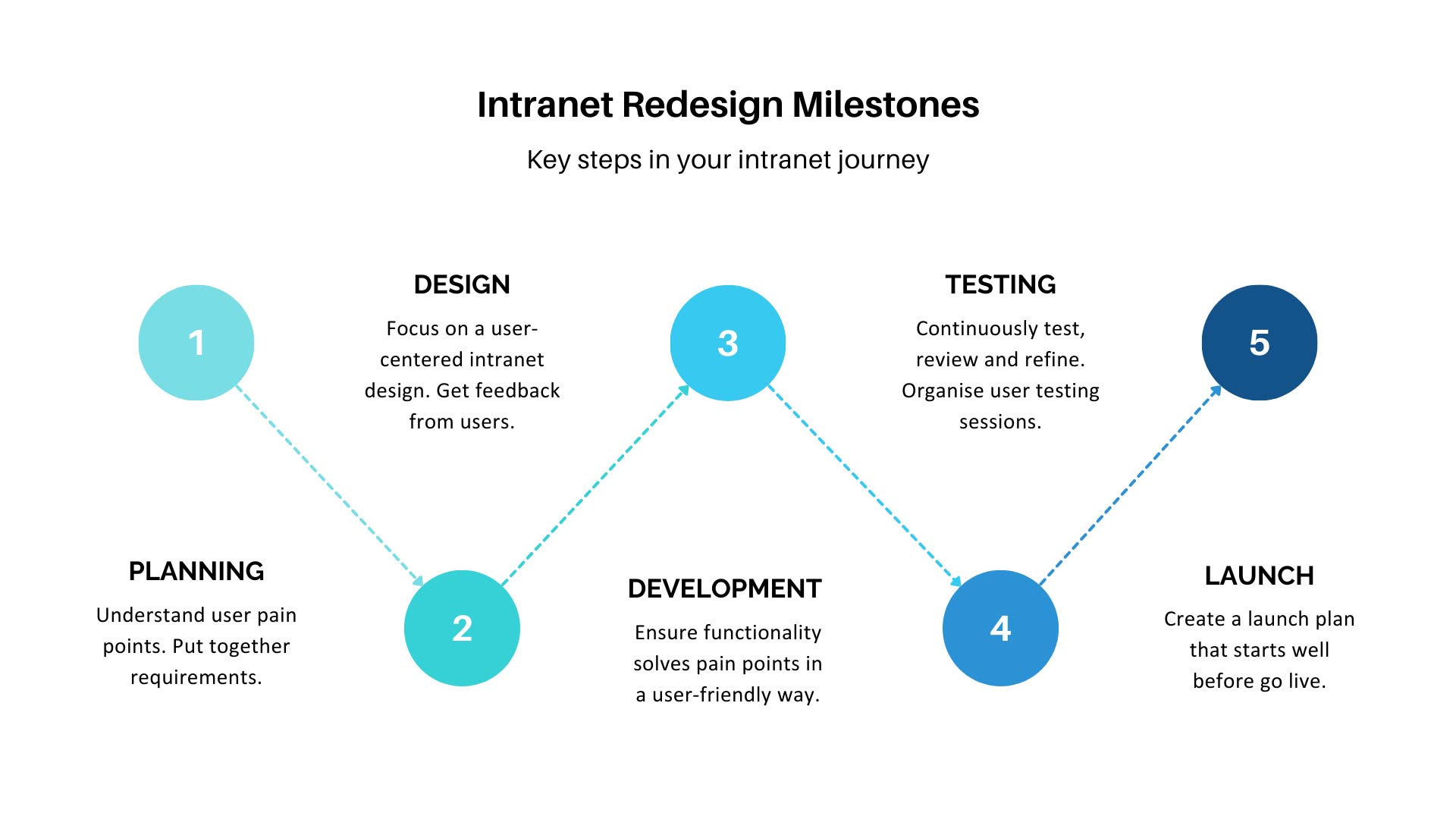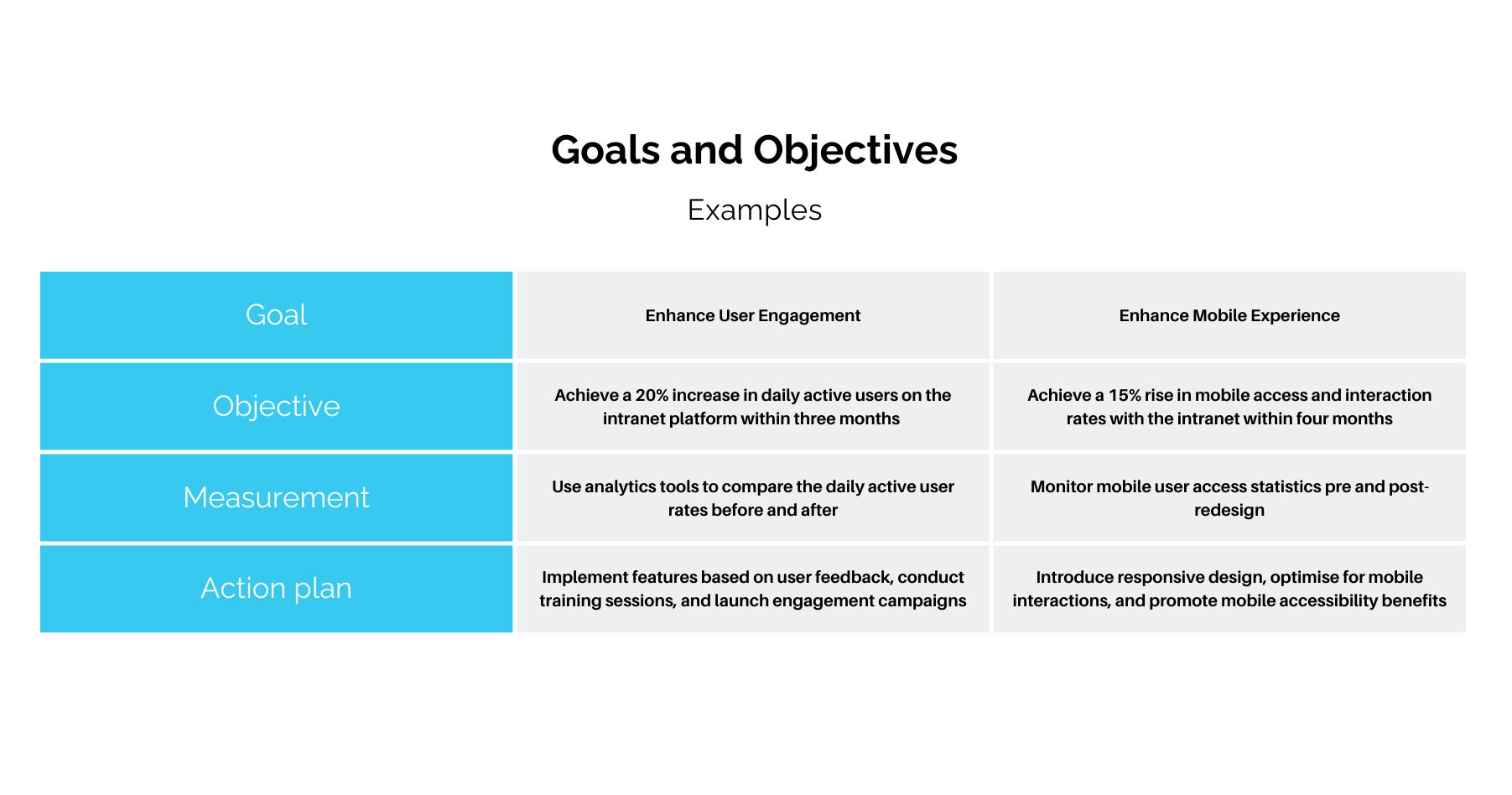With the increase in employees working across different locations, intranet software have become the foundation of their digital workplaces.
They serve as a launchpad to various systems within the organisation, facilitating information flow, transparent communication, and cultural expression.
This article explores the driving forces behind an intranet redesign and the design process, walking you through key milestones to ensure your project's success.
Why Redesign Your Intranet?
As effective as intranets can be, there are many existing intranet deployments that are outdated and no longer provide the value needed for organisations. Consider the intranet signs that you need to upgrade your intranet:
Adapting to Evolving Business Needs
Business strategies evolve, and so should your intranet. If the current setup is no longer aligned with strategic goals or if it fails to support new business processes, it's time to consider a redesign.
Not sure if its still aligned or not? Start with detailed stakeholder interviews to understand the gaps in the current system and to align on the goals of the redesign (if needed).
Enhancing User Experience
A user-centered intranet redesign is paramount. If users are struggling with navigation, or if there’s a high volume of support queries related to the intranet use, these are clear indicators that user experience is lacking.
Incorporate feedback mechanisms and user surveys into the planning phase to ensure the redesign truly caters to the needs and preferences of the workforce. There are also a range of navigation best practices that can significantly enhance intranet effectiveness.
Boosting Employee Engagement and Productivity
An intranet should be a vibrant hub that employees visit not just because they have to, but because they want to.
A fresh design can reinvigorate engagement, streamline workflows, and boost overall productivity.
Ask yourself if your current intranet platform has tools and functionality that enable these outcomes like social tools, personalisation features, and mobile accessibility.
Keeping Pace with Technology Advances
Technology is continually progressing, offering new capabilities that can significantly benefit your intranet's functionality and security.
Evaluate the latest technologies and reflect on what your existing intranet is missing.
Increasing adoption and utilisation
A redesign can readdress the relevance of the intranet content and ensure that the tools and resources provided are actually utilised.
Look at analytics to understand what's being used and what's not.
Intranet redesign best practice suggests a focus on simplification and decluttering, removing outdated content and features that no longer serve a purpose.
Streamlining for Efficiency
With a dispersed workforce, efficiency becomes even more critical.
When planning your intranet project you should aim to streamline operations, automating routine tasks, and providing employees with quicker access to the information and tools they need.
Ensuring Compliance and Security
As cyber threats evolve, your intranet must remain secure. A redesign can address any vulnerabilities and update security measures.
It's also an opportunity to ensure the intranet complies with data protection regulations and corporate governance requirements.
Want some inspiration? Check out '3 Successful Intranet Examples to Inspire You'.
What is an Intranet Redesign Project Plan?
An intranet redesign project plan is a strategic document that meticulously outlines the process of overhauling this system.
It's a vision-turned-scheme, translating abstract goals for improved communication, productivity, and engagement into actionable, measurable steps.
Why Bother Having One?
Building or improving a corporate intranet starts with a solid plan.
Why should organisations invest time in creating an intranet redesign project plan?
Here's the crux of its value:
- Direction and Clarity: Without a clear plan, intranet redesigns can become directionless, succumbing to scope creep or veering off budget. A project plan keeps the project on course and stakeholders aligned.
- Resource Management: It serves as a guideline for managing both human and technical resources, ensuring that no part of the redesign process is under-resourced or overextended.
- Communication Tool: A project plan is a vital communication tool. It informs all involved parties — from IT to communications, to executive teams — of their roles, expectations, and the impact of the redesign.
- Measurement of Success: By setting clear objectives and milestones, the plan becomes a benchmark against which the success of the redesign can be measured. This is critical in justifying the investment and evaluating the intranet’s performance post-launch.
- Change Management Facilitation: Redesigning an intranet is as much about managing change as it is about technology. The plan addresses how to handle the human side of the change, ensuring a smooth transition for all users.
- Improve Employee Experience: Intranets operate within a larger digital ecosystem all designed to improve the overall employee experience. Without a solid plan in place, your new intranet could be hindering, not improving the employee experience within your organisation.
Intranet Redesign Milestones
This redesign isn't merely about a fresh look; it's about enhancing functionality, user experience, and overall efficiency. This requires several key steps or milestones.

1. Planning and Survey
Every successful intranet redesign project plan starts with thorough planning and surveying. Begin by determining what works in your current intranet and what doesn't.
Gather feedback directly from the users; after all, they're the ones navigating it daily. Also, make sure to choose an intranet vendor who has a comprehensive project lifecycle process to guide you through the experience smoothly.
Tip: Use surveys or focus groups to understand user needs and pain points. This phase is crucial for intranet project planning, ensuring your redesign is user-centered.
2. Design
The design phase is where your intranet starts to take a visual shape. It's not just about aesthetics; it's about creating an interface that’s intuitive, responsive, and aligns with your brand.
Tip: Collaborate with your design team in-house, as well as the design team from the provider you have chosen and ensure they understand the feedback from the survey phase. Remember, the aim is a user-centered intranet redesign, focusing on functionality as much as aesthetics.
3. Development
Now, it's time to move from sketches and wireframes to the actual build. Your developers will be front and centre during this phase, crafting the intranet's features and ensuring it's technically sound.
Tip: Regularly review progress and ensure there's open communication between the design and development teams. This collaborative approach is a cornerstone of the intranet design process.
4. Fine-Tuning and Testing
After the initial build, it's time to refine. This involves rigorous testing, debugging, and ensuring everything runs smoothly. It's the phase where minor adjustments can make a significant difference.
Tip: Organise user testing sessions. By giving a select group of employees early access, you can gather valuable feedback and make necessary tweaks before the final rollout.
5. Launch and Adoption
You've made it to the finish line — almost. Launching the intranet is a big milestone, but ensuring its adoption is equally vital. This is where your internal communications shine.
Tip: Create an intranet project plan for the launch, including training sessions, tutorials, and support resources. Celebrate the launch, but also ensure employees feel supported in navigating the new platform.
Important Elements of a Successful Redesign Plan
A project plan for an intranet redesign is far more than a set of instructions; it's the narrative of your organisation's future way of working.
It starts by encapsulating the current intranet's pain points — be they outdated design, poor user experience, or clunky functionality.
From there, it addresses the 'why' and the 'how' of moving forward: why your intranet needs a revamp and how to go about achieving this transformation.
Drawing from our extensive experience, we've outlined the critical elements that should be at the heart of your intranet redesign project plan. Let's dive in!
1. Goals and Objectives
What are the overarching business goals driving this redesign? Ask yourself – what do you hope to achieve with this redesign? These may include enhancing internal communication, streamlining workflows, or facilitating better knowledge management.
Tip: Establish measurable KPIs. Whether it's user engagement metrics or reduced search times, having tangible metrics will guide the intranet project planning and ensure alignment with broader organisational objectives.
Examples

2. Scope and Scale
When considering the extent of your redesign, it's crucial to determine whether you're merely updating the aesthetics or delving deeper into a complete transformation. The scope and scale of the project will inherently dictate various aspects such as the timeline, resources, and budget.
Tip: Clearly document the boundaries of your redesign. Whether it's integrating new technologies or transitioning to a different platform, every element should be defined from the outset. This clarity will prevent project scope creep and ensure the redesign stays on track.
3. Budget
It's vital to outline the potential costs early on to ensure that there are no unexpected expenses down the track. This includes software, training, external consultancies, and ongoing maintenance. Consider implementing an intranet-in-a-box aka an intranet packaged solution with pre-determined pricing tiers.
Tip: Be transparent about your budgetary constraints. Engage with vendors who can provide scalable solutions, ensuring you get maximum value without compromising on quality.
4. Risk Assessment
Every project carries inherent risks, be it technological, financial, or operational. A well-thought-out intranet redesign project plan will not only identify these risks but also chart out mitigation strategies to address them. Whether it's potential data loss, employee resistance, or project delays, being prepared can make all the difference.
Tip: Adopt a proactive stance. Regularly review and update your risk assessment as the project progresses. Encourage stakeholders to voice potential concerns, ensuring a comprehensive risk profile.
5. Timeline
Every successful project needs a realistic and achievable timeline. This doesn't just mean setting a launch date; it involves plotting out each step, from initial brainstorming sessions to post-launch reviews. By clearly marking out each phase, you ensure that stakeholders have a consistent view of the project's progression.
Tip: Build in buffer periods. Projects rarely go exactly to plan, so having a few contingency days can help accommodate unforeseen delays or changes.
6. Involvement of Key Stakeholders
Your intranet impacts everyone, from the C-suite to the newest hire. Engage with key stakeholders early in the process. Their insights can provide invaluable perspectives on the features and functionalities that truly matter.
Tip: Hold regular brainstorming sessions and foster an environment where stakeholders feel encouraged to share their insights and feedback.
7. Survey Data/Needs Assessment
Before diving into the intranet design process, it's crucial to understand your users' needs. Conduct surveys, hold focus groups, and analyse usage data from your current intranet.
Tip: Prioritise areas that consistently emerge as pain points. Addressing these will significantly enhance user experience.
8. User-Centred Design
An intranet should be intuitive, accessible, and tailored to its users. Implement a user-centered intranet redesign approach, ensuring that every design choice enhances the user experience.
Tip: Create personas representing different user groups. Design keeping these personas in mind, ensuring varied needs are catered to.
Vita Group, for example, redesigned their intranet to be personalised based on role and business area, powered by permissions within Active Directory groups, resulting in a need to design and maintain one version of a page. For example a clinician working in an Artisan clinic is shown an Artisan navigation menu item, alongside standard menu items linking to common services for all team members. They would also see corporate news and Artisan-related news, displayed via dynamic widgets which brings like-minded articles together onto one page, as well as updates from the Artisan Yammer group.
9. Content Strategy
The content populating your intranet should be relevant, updated, and organised. Devise a clear strategy dictating content creation, curation, and archiving processes.
Tip: Regularly review and update content. An intranet bustling with outdated information can hinder rather than help.
10. Robust Governance Model
Last, but certainly not least, is governance. Who will oversee the intranet post-launch? Establishing a clear governance model ensures the platform remains aligned with its initial objectives and continues to evolve positively.
Tip: Appoint a dedicated intranet team or committee responsible for its ongoing management, content updates, and user feedback.
How Elcom Helps Businesses Successfully Redesign their Intranet
Through engaging in intranet project planning and adherence to intranet redesign best practices, your organisation can build an intranet that not only looks contemporary but also enriches the day-to-day experiences of its users, ultimately contributing to the success of the business as a whole.
Still not sure where to start? The Elcom team can help! We’ve been launching successful award-winning intranets that make a real difference to employees, for over a decade. We have an expert in-house team of business analysts, designers, developers and project managers who can you ensure you launch the intranet you need, within time and budget. You can focus on your own day to day tasks, knowing your project is in capable hands.
Looking for additional resources? Watch our popular webinar recording ‘Intranet Strategy: A Roadmap for Success’. In just 30 minutes, you’ll discover a roadmap for success. We’ll delve into what goes into a successful intranet strategy that drives both employee engagement and real business value.
